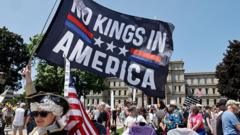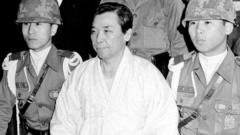Protests sweeping the US highlight deep divisions over Trump’s immigration policies and the symbolic militarization of his presidency, showcasing a mobilized opposition amid an extravagant military celebration.
Massive Protests Erupt Across Nation as Trump Holds Military Parade

Massive Protests Erupt Across Nation as Trump Holds Military Parade
Nationwide demonstrations target Trump's policies as military parade draws criticism and crowds.
A wave of protests organized by the grassroots movement "No Kings" engulfed cities across the United States in response to President Trump’s rare military parade held in Washington, D.C. The demonstrations, which coincided with Trump’s birthday, were organized to push back against his administration’s controversial policies, particularly regarding immigration.
Across the nation, from New York to Los Angeles, protestors gathered in solidarity against Trump’s stance on immigration and the militaristic show of force he orchestrated to mark the 250th anniversary of the U.S. Army. Billboards were replaced with American flags and protest signs as speakers took to the podium in various cities, voicing concerns over Trump’s alleged overreach as president.
In Philadelphia, a nurse named Karen Van Trieste expressed her reasons for attending the protest, citing the administration’s cuts to public health as a substantial concern; “I just feel like we need to defend our democracy,” she said. Meanwhile, in Los Angeles, civic leaders heightened their vigilance after prior demonstrations turned violent against a backdrop of deportation raids and heightened enforcement—an issue that drew hundreds into the streets. Jose Azetcla, representing the civil rights group Brown Berets, echoed the sentiments of many dissenters: “It’s not harsh, it’s evil. You don’t separate families.”
The parade, which Trump characterized as a celebration of military strength, was met with warnings for would-be protestors that “heavy force” would be employed against any disruptions. This pronouncement did little to deter crowds. Organizers boasted of hundreds of simultaneous demonstrations, and although estimates of attendance varied, a CBS/YouGov poll taken just days before found that Trump's immigration policies retain notable support, with 54% approval regarding deportations of undocumented immigrants.
The protests also prompted concerns regarding national unity, as many viewed the juxtaposition of soldiers marching in celebration, while simultaneously, troops were deployed for domestic policing efforts. Experts raised alarms at this unsettling blend of militarism and political dissent. Security analyst Barbara Starr observed, “This polarisation over this immigration debate overshadows this parade in a way that might not have been anticipated by the military.”
As the president saluted service members in a display with a budget estimated between $25 million to $45 million, many attendees, like Vietnam veteran Melvin Graves, considered it a heartfelt tribute to the troops. Graves reflected on his own experiences, remarking, “This is about honouring these men and women who served.” The militaristic event marked the first of its kind since George H.W. Bush’s Gulf War victory parade in 1991.
However, for many Americans, Saturday’s lavish display was overshadowed by the visual of tear gas dispersing protestors paid in blood from socio-political divisions. In Minnesota, some demonstrations were even canceled amid security concerns following a tragic shooting incident. Despite these challenges, a significant number of individuals felt compelled to march, showing the fracture line that Trump's presidency continues to highlight within American society.




















